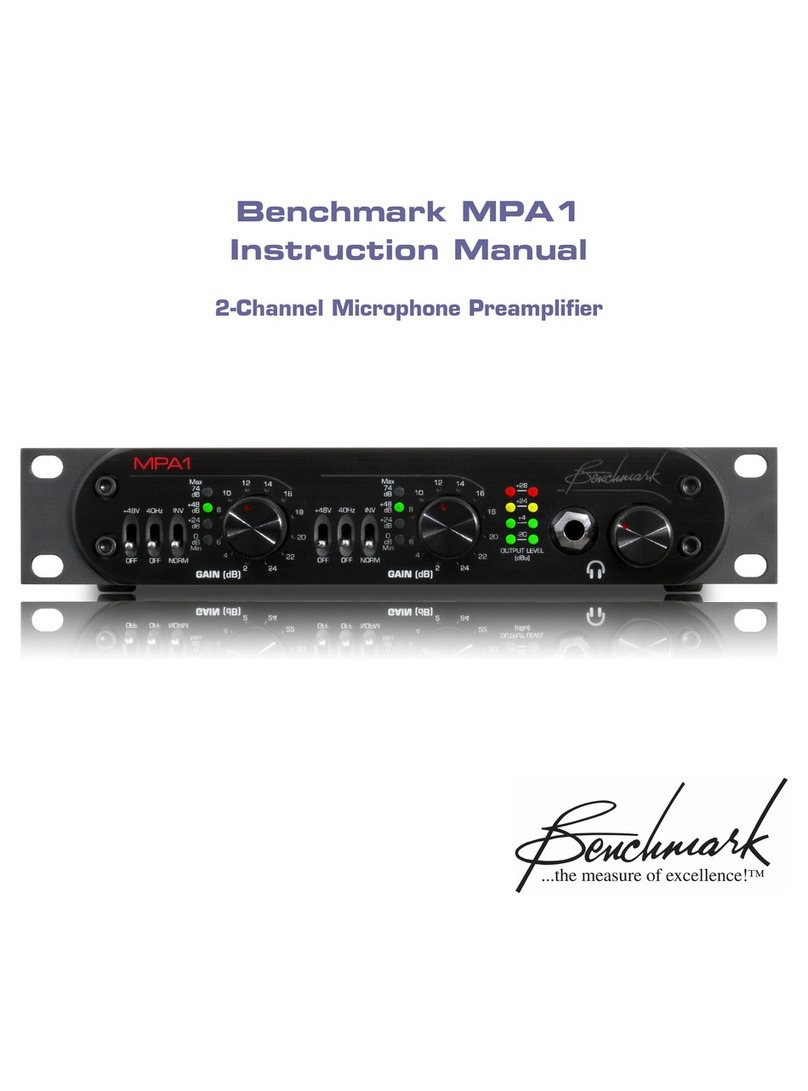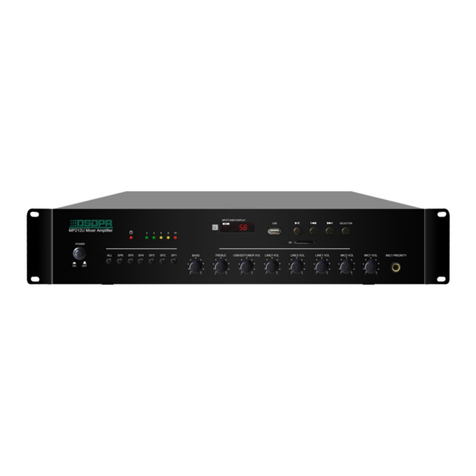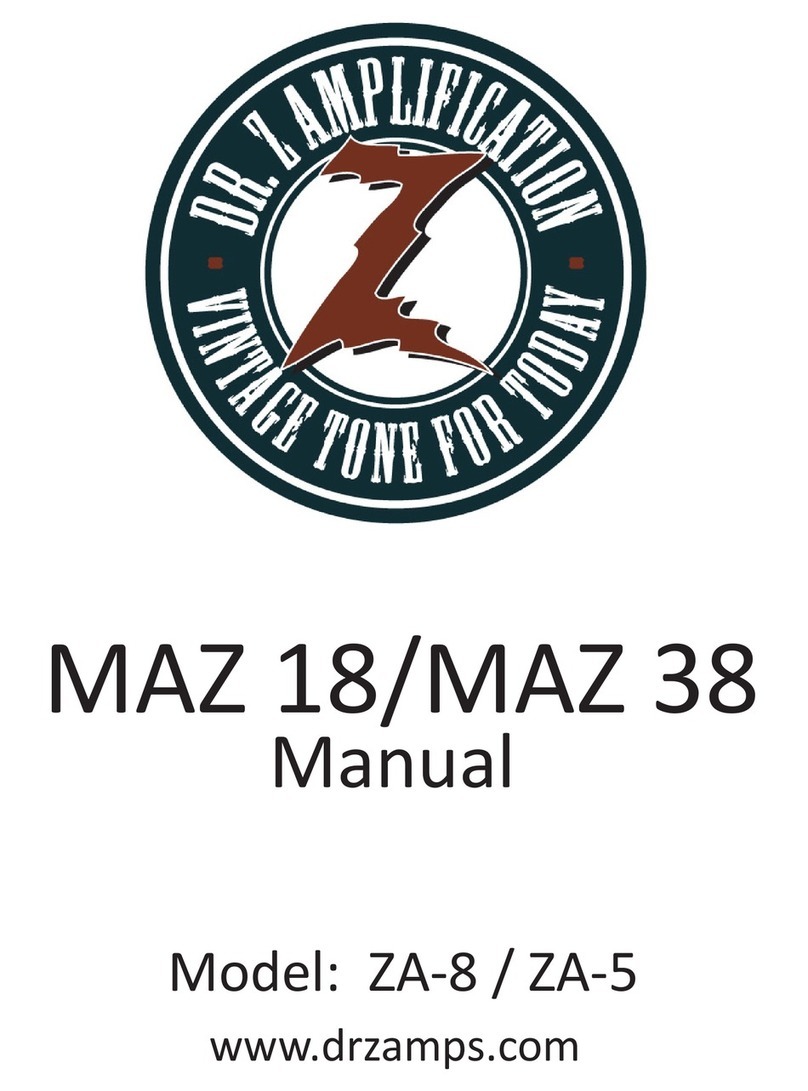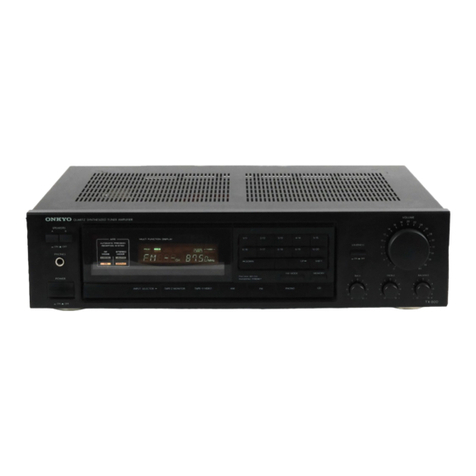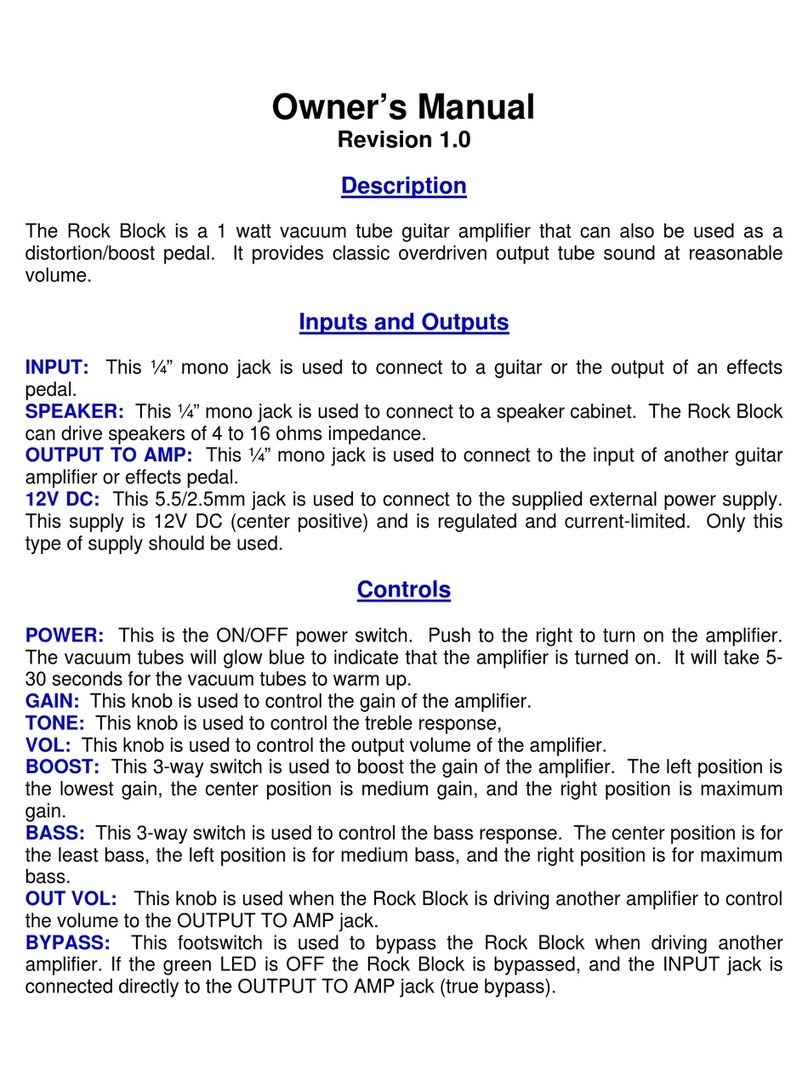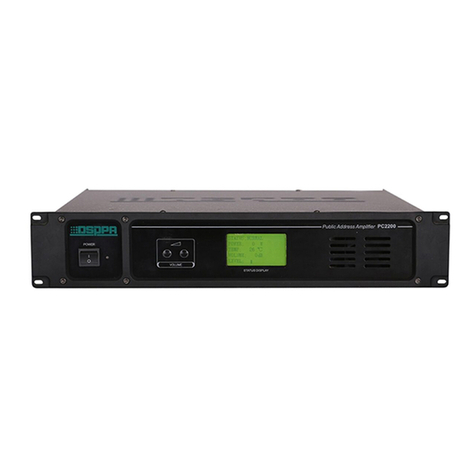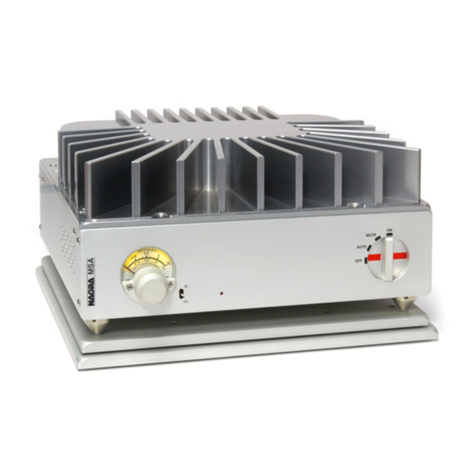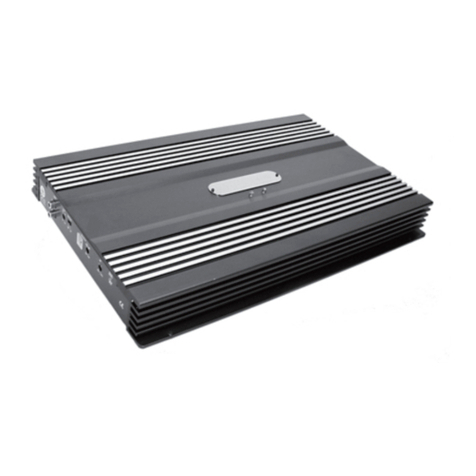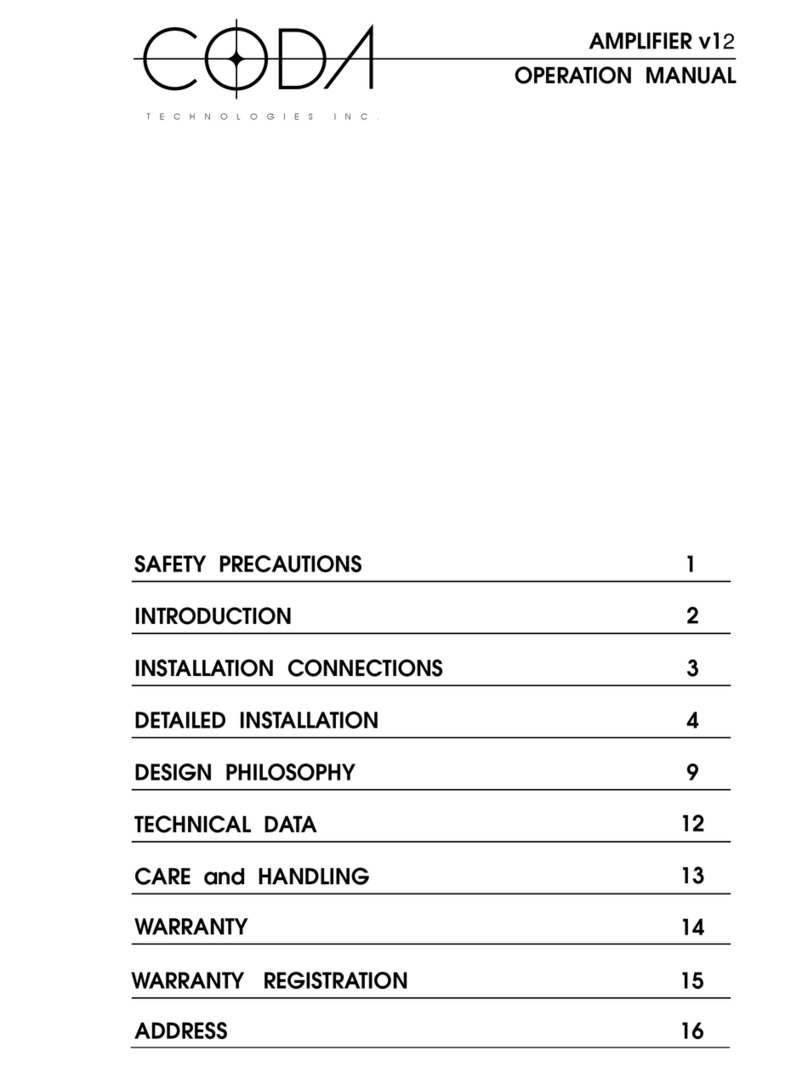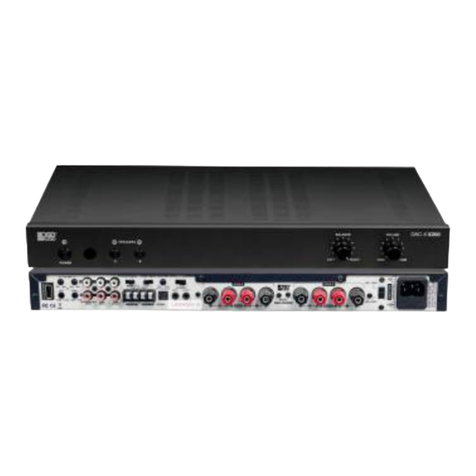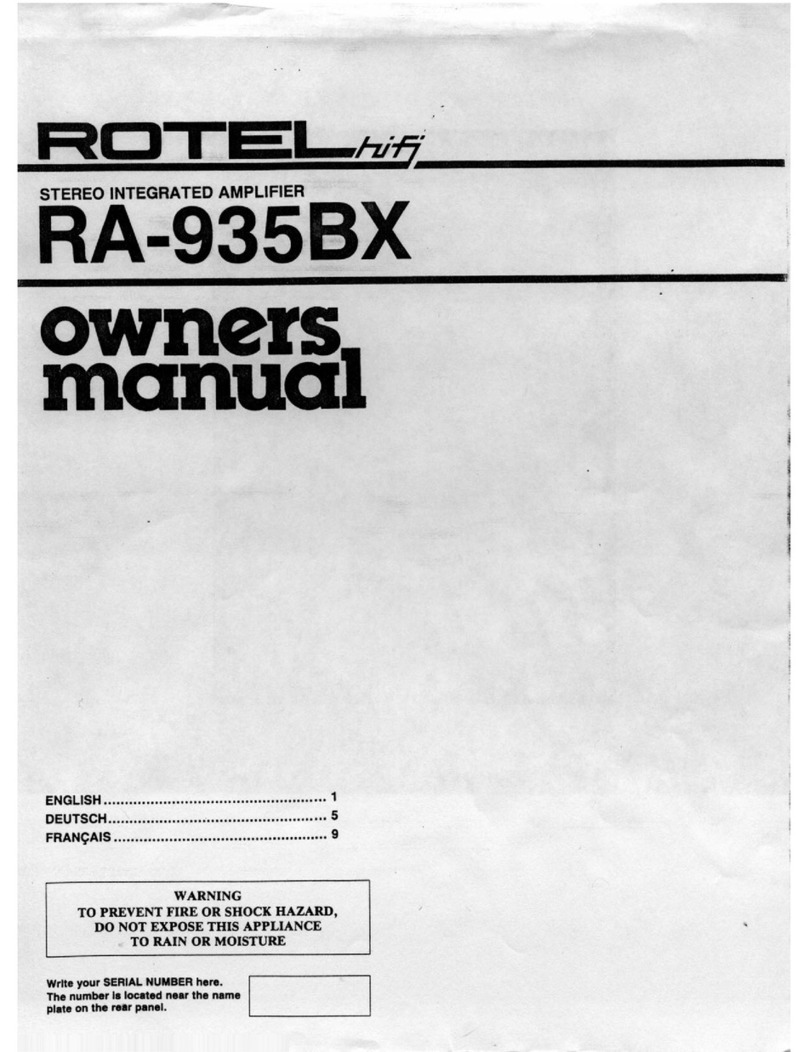Benchmark DAC2 D User manual

Benchmark DAC2 D
Instruction Manual
Reference Stereo Preamplifier
PCM and DSD D/A Converter
Asynchronous USB
ESS9018 Conversion System
(Version 2.X Firmware)

Manual for DAC2 D with 2.X Firmware - Rev. H Page 2
Safety Information
Fuses
CAUTION: FOR CONTINUED FIRE
HAZARD PROTECTION ALWAYS REPLACE
THE FUSES WITH THE CORRECT SIZE
AND TYPE (0.5A 250 V SLO-BLO® 5 X 20
MM –LITTELFUSE® HXP218.500 OR
EQUIVALENT). THE FUSE DRAWER
INCLUDES TWO FUSES. ALWAYS
REPLACE BOTH FUSES AT THE SAME
TIME.
AC Input Voltage Range
NOTE: THE DAC2 IS EQUIPPED WITH A
UNIVERSAL POWER SUPPLY. THERE IS
NO VOLTAGE SELECTION SWITCH. AC
VOLTAGE RANGE IS 88-264 VAC, 50-60
HZ. THE PRODUCT MAY ALSO BE
OPERATED FROM DC POWER OVER A
VOLTAGE RANGE OF 125-373 VDC.
Power Cord
CAUTION: ALWAYS USE A GROUNDED
POWER CORD. THE PRODUCT IS
EQUIPPED WITH A STANDARD IEC
POWER ENTRY MODULE. USE AN IEC
POWER CORD THAT IS EQUIPPED WITH
THE APPROPRIATE CONNECTOR FOR
YOUR LOCATION. CORDS ARE AVAILABLE
FROM YOUR DEALER.
Modifications
CAUTION: DO NOT SUBSTITUTE PARTS
OR MAKE ANY MODIFICATIONS
WITHOUT THE WRITTEN APPROVAL OF
BENCHMARK MEDIA SYSTEMS, INC.
MODIFICATION MAY CREATE SAFETY
HAZARDS AND VOID THE WARRANTY.
CAUTION: CHANGES OR MODIFICATIONS
NOT EXPRESSLY APPROVED BY
BENCHMARK MEDIA SYSTEMS COULD
VOID THE USER'S AUTHORITY TO
OPERATE THE EQUIPMENT UNDER FCC
REGULATIONS.
Repairs
CAUTION: DO NOT SERVICE OR REPAIR
THIS PRODUCT UNLESS PROPERLY
QUALIFIED. ONLY A QUALIFIED
TECHNICIAN SHOULD PERFORM
REPAIRS.

Manual for DAC2 D with 2.X Firmware - Rev. H Page 3
Contents
Safety Information 2
Fuses 2
AC Input Voltage Range 2
Power Cord 2
Modifications 2
Repairs 2
Features 4
Introduction 5
Applications 5
DAC2 vs. DAC1 5
DAC2 Technologies 5
Front Panel 8
Rear Panel 8
Quick Start Guide 9
Audio Inputs 9
Remote Control 9
Front Panel Controls 10
Front Panel Displays 11
Headphone Jacks 13
Operational Details 14
DIM and MUTE Functions 14
Auto-On Function 14
HT Mode 15
Preamp COMPATIBILITY Mode 16
USB MODE Selection 16
Driving Power Amplifiers 17
HPA2™ Headphone Amplifier 17
Digital Pass-Through 18
Firmware Version Identification 19
Rear Panel 20
Inputs 20
Outputs 23
AC Power-Entry and Fuse Module 24
Internal Settings 25
Jumper-Configured Options 25
Removing Top Cover 25
XLR Output Pads 25
Headphone Switch Configuration 26
Headphone Amplifier Gain 27
Digital PASS-THROUGH Function 28
Rack Mounting 29
Benchmark Rack Mount Tray 29
Benchmark ½-Wide Blank Plate 29
DAC1, DAC2 Family History 30
DAC1 Series 30
DAC2 Series 30
Benchmark Technologies 32
Hybrid Gain Control™ 32
Native DSD Conversion 32
High Headroom DSP 32
32-bit SABRE-PRO D/A System 35
Diagnostic Displays 35
Distributed Power Regulation 35
HPA2™ Headphone Amplifier 35
Differential Amplifiers 36
Jitter-Immune UltraLock2™ 36
Multi-Mode Asynchronous USB Audio 39
USB Driver Installation 41
Performance Graphs 46
Specifications 62
Audio Performance 62
Group Delay (Latency) 63
Digital Audio Inputs 63
Jitter Tolerance 63
Balanced Analog Outputs 64
Unbalanced Analog Outputs 64
HPA2TM Headphone Outputs 64
Status Display 65
AC Power Requirements 65
Dimensions 65
Weight 65
Regulatory Compliance 66
FCC and RoHS Compliance Statements 66
FCC Notice (U.S. Only) 66
RoHS Compliant Information 66
CE Certificate of Conformity 67
Warranty Information 68
Benchmark 1-Year Warranty 68
Benchmark Extended Warranty Options 69
Notes on Warranty Repairs 69

Manual for DAC2 D with 2.X Firmware - Rev. H Page 4
Features
HGC™(Hybrid Gain Control) –combines motor-driven active analog potentiometers, 32-bit
digital attenuators, and passive analog attenuators, to achieve state-of-the-art performance
Low-Impedance Passive Output Pads –0, 10, and 20 dB –optimize output level to power
amplifiers and other downstream devices to maximize system SNR (Page 26)
SABRE PRO - 32-bit PCM D/A conversion system, four 32-bit D/A converters per channel
SABRE PRO –Native DSD D/A conversion system, four 1-bit DSD D/A converters per channel
Benchmark UltraLock2™ Jitter Attenuation System –eliminates jitter-induced distortion
High Headroom DSP - provides 3.5 dB of analog and digital headroom above 0 dBFS to
completely eliminate the clipping of intersample peaks
Multi-Mode Asynchronous USB Audio 2.0 –24 bit/192 kHz, DSD (DoP 1.1)
Driverless Asynchronous USB Audio 1.1 –24-bit/96 kHz
Sample Rate Display –displays the measured sample rate, and format (PCM or DSD)
Word Length Display –displays the measured word length
HPA2™ reference-grade "0-Ohm" headphone power amplifier with dual high-current
outputs
HPA2™ gain jumpers for customizing headphone output gain for headphone sensitivities (Page
26)
2 Headphone Output Jacks –one jack automatically mutes the main outputs , mute feature
can be disabled (Page 26)
2 Coaxial Digital Inputs –24-bit/192 kHz PCM, DSD (DoP 1.1)
2 Optical Digital Inputs –24-bit/96 kHz PCM
1 Coaxial Digital Output –digital pass through from USB, Coax, and optical inputs when
function is enabled (Page 28)
3 Stereo Analog Outputs –1 pair balanced (XLR), plus 2 pairs unbalanced (RCA)
IR Remote with metal housing provides control of all functions (optional on some models)
HT Bypass –sets outputs to calibrated levels - all inputs can be individually programmed
(Page 15)
Polarity Switch –inverts the polarity of selected digital inputs
Mute –accessible from remote or front panel
Dim –Reduces output level by 20 dB, accessible from remote or front panel
Automatic De-Emphasis –automatically responds to consumer pre-emphasis bit (44.1, 48
kHz)
AUTO-ON Function - can be programmed to turn on when AC is applied (Page 14)
Power Switch –very low standby power , <0.5 W at 120 VAC
High-Efficiency Low-Noise Power Supplies –only 12-15 W, 88-264 VAC, 50-60 Hz
Meets FCC Class B and CE emissions requirements
Tested for immunity to radiated and conducted RF interference

Manual for DAC2 D with 2.X Firmware - Rev. H Page 5
Introduction
Applications
The DAC2 D is a professional reference-grade
audio digital to analog converter with
Benchmark's HPA2™headphone amplifier.
The DAC2 D supports 24-bit D/A conversion
of PCM at sample rates up to 192 kHz. It also
supports direct conversion of 1-bit DSD at a
2.8224 MHz sample rate. It is designed to be
very transparent and this makes it well-suited
for critical monitoring in studio control rooms
and mastering rooms.
The DAC2 D is also well-suited for high-end
hi-fi environments. It includes a generous
collection of inputs and outputs and can serve
as the central component in any stereo hi-fi
system. The DAC2 D provides D/A
conversion, source selection, volume control,
and headphone amplification. A remote
control and a home theater bypass function
provide the features needed in a home
environment.
The DAC2 D is designed to directly drive a
wide variety of power amplifiers and powered
monitors. The balanced outputs include low-
impedance passive pads that can be adjusted
to optimize the interface between the DAC2
Dand the power amplifier. This optimization
can provide substantial improvements in the
system-level SNR and THD+N performance.
DAC2 vs. DAC1
The DAC2 D adds these features that are not
found on the DAC1:
Asynchronous 192kHz USB Audio 2.0
32-bit D/A conversion system
Word Length Display
Sample Rate Display
Polarity Control
Direct DSD D/A Conversion
-20 dB DIM
Power Switch with Auto-On Function
Home Theater Bypass
Digital Pass-Through
High-Headroom DSP
Dual-Domain Hybrid Gain Control
Additional I/O
DAC2 Technologies
4:1 Parallel Conversion Structure
The conversion system in the DAC2 achieves
a 6 dB signal to noise improvement through
the use of 4:1 summing. The ES9018 D/A is
an 8-channel 32-bit converter. In the DAC2,
four channels are summed in the analog
domain to form each of the two output
channels.
The 4:1 summing also improves the THD. The
non-linearities in individual conversion
channels are averaged across the four
summed channels and incoherent non-
linearities are attenuated by 6 dB.
High-Headroom Digital and Analog
Processing
The DAC2 has generous amounts of analog
and digital headroom. The analog clip point is
above 29 dBu. The digital clip point is 27.5
dBu. When operating at a typical -20 dB at
+4 dBu studio calibration, the DAC2 has 3.5
dB of digital headroom above 0 dBFS. This
digital headroom prevents the clipping of
intersample overs.
No Clipping of Intersample Overs
The DAC2 is one of very few D/A converters
that can accurately reproduce intersample
overs without clipping. Intersample peaks can
reach +3.01 dBFS and commonly occur many
times per second in most 44.1 kHz and 48
kHz recordings. When recordings are ripped
using lossy compression systems (such as
MP3), additional intersample overs are often
created. Most converters (including the
DAC1) produce bursts of distortion at every
occurrence of an intersample over. In
contrast, the DAC2 converters cleanly
reproduce all intersample overs.
Low-Noise Power Supplies
The DAC2 uses high-efficiency low-noise
power supplies. Each critical subsystem also

Manual for DAC2 D with 2.X Firmware - Rev. H Page 6
has at least one dedicated low-noise
regulator. The high-efficiency supplies deliver
the substantial power required by the low-
impedance circuits, the headphone amplifier,
and the output line drivers. A power switch is
included. The standby power consumption is
less than 0.5 W when the unit is off.
Low Magnetic Emissions
The magnetic components in the DAC2 power
supplies operate at over 800 kHz. This allows
the use of very small magnetic components
that emit correspondingly small magnetic
fields. This virtually eliminates all traces of
line-frequency components in the output
spectrum of the DAC2. This also means that
the DAC2 can be placed in close proximity to
any audio component without causing
interference with the other component.
UltraLock2™Clock System
UltraLock2™provides the outstanding jitter
attenuation.
Dual-Mode USB Input
The DAC2 has a USB input that can be
operated in two modes; driverless USB
Audio 1.1, and a high sample rate USB
Audio 2.0. Both use asynchronous clocking
to eliminate the USB interface as a source of
clock jitter.
Note: To provide full backward and forward
compatibility, the DAC2 uses the DAC2 USB
drivers. This prevents the need to install two
different sets of drivers. Please note that the
DAC2 USB input will be identified as
"Benchmark DAC2" in your computer control
panels.
Asynchronous USB Audio 2.0
The USB Audio 2.0 interface supports DSD
and 192 kHz, 24-bit PCM. No drivers are
required for Apple operating systems. Drivers
are provided for Windows operating systems
at: BenchmarkMedia.com/drivers
Native Asynchronous USB 1.1
The DAC2 has a driverless USB Audio 1.1
mode that supports 96 kHz, 24-bit PCM with
all operating systems. This mode provides a
quick and easy connection to a wide variety of
computers and tablets without installing a
driver.
HGC™ Hybrid Gain Control
HGC™ is Benchmark’s unique hybrid gain
control that combines analog and digital gain
control into a single volume control knob.
The HGC™ system uses an active analog gain
control for analog inputs (if equipped) and a
32-bit dithered volume control for digital
inputs. Both types of inputs leverage the low-
impedance passive analog attenuation system
at the XLR outputs.
The dual-domain HGC™ system combines the
high dynamic range of Benchmark’s HDR™
analog control (used in the DAC1 HDR) with
the low distortion and accuracy of a digital
control. HGC™ outperforms traditional analog
or digital volume controls, including the two-
stage DAC1 HDR™ system. Musical details
are preserved over a very wide range of
output levels. Analog inputs are controlled in
the analog domain. Digital inputs are
controlled in both domains (32-bit digital
volume plus passive analog attenuators).
The volume control is a servo-driven analog
potentiometer. This control rotates in
response to commands from the remote
control while providing the convenience of
manual adjustments with a physical knob.
Low-Impedance Passive Attenuators
Like the DAC1, the DAC2 includes low-
impedance passive attenuators on the XLR
outputs. These attenuators can be adjusted to
optimize the interface with the power
amplifier or powered monitors. This
optimization places the volume control in its
best operating range. This exclusive
Benchmark feature can provide substantial

Manual for DAC2 D with 2.X Firmware - Rev. H Page 7
improvements in the performance of the
playback signal chain.
Native DSD Conversion
The DAC2 supports native DSD conversion.
This feature was not available on the DAC1.
DSD signals can be delivered to the USB or
Coaxial inputs in DoP 1.1 format. The DSD
signal is then routed directly to a bank of 1-
bit DSD D/A converters. Four balanced 1-bit
converters are summed together for each
balanced output.
Digital Pass-Through
The second coaxial input (D4) can be
reconfigured as a digital output. When
operating as an output, any selected digital
input is passed through to D4 without any
processing. Optical, coaxial, and USB inputs
can be passed through to the D4 connector.
This even includes special signals such as
DoP, DTS, Dolby Digital, even when these
signals cannot be decoded by the DAC2.
Polarity Control
Each digital input can be inverted, to correct
polarity problems. Some listeners report that
polarity is incorrect on some recordings, and
that they enjoy an improved listening
experience when this is corrected. To toggle,
use the POLARITY button on the front panel
or press and hold the ON button on the
remote.
HT Mode
The HT mode sets the volume control to a
calibrated level that is near its maximum
setting. In HT mode the analog gain is set to
0 dB (unity gain). Likewise the digital
attenuation is set to 0 dB (maximum output).
The HT light is illuminated when the HT mode
is active.
The HT mode is similar to the CALIBRATED
switch setting on the DAC1 except that it is
programmable per input. This flexibility allows
seamless integration into home theater
systems where the DAC2 handles the main
left and right channels.
Auto-On Function
The DAC2 can be programmed to
automatically turn on when AC power is
applied (Page 14).

Manual for DAC2 D with 2.X Firmware - Rev. H Page 8
Front Panel
Rear Panel

Manual for DAC2 D with 2.X Firmware - Rev. H Page 9
Quick Start Guide
Audio Inputs
The DAC2 D features five stereo digital inputs
(2 coaxial, 2 optical, and 1 USB). The coaxial
and optical inputs accept professional (AES)
and consumer (S/PDIF) data formats at word
lengths up to 24-bits.
Tip: We recommend using the coaxial or USB
inputs for sample rates above 96 kHz. Optical
interfaces are not always reliable at sample
rates above 96 kHz.
Remote Control
The remote control is designed to have a long
operating range. In most applications it is not
necessary to point the remote directly at the
DAC2 D.
The chart at the right summarizes the
functions of the IR remote control.
OFF
Turns the unit off.
ON
Turns the unit on.
Press and hold the ON button for
3 seconds to toggle the
POLARITY function.
VOLUME
Turns the volume up or down.
DIM
Toggles the -20 dB DIM function.
MUTE
Toggles the MUTE function.
Press and hold the MUTE button
for 3 seconds to toggle the HT
mode on the selected input.
INPUT
Selects the inputs.
D1
Selects optical digital input D1.
D2
Selects optical digital input D2.
D3
Selects coaxial digital input D3.
D4
Selects coaxial digital input D4.
USB
Selects USB input.
Press and hold the USB button for
3 seconds to toggle between the
USB 1.1 and USB 2.0 modes.
Analog
Not used.

Manual for DAC2 D with 2.X Firmware - Rev. H Page 10
Front Panel Controls
The front panel controls duplicate all of the
functions that are available from the remote
control.
Two additional functions, AUTO-ON, and
COMPATIBILITY mode are only controllable
from the front panel.
The AUTO-ON function keeps the
DAC2 D on whenever AC line voltage
is supplied.
The COMPATIBILITY mode disables
the volume control when the DAC2 D
feeds a preamplifier that will be used
to control the system playback
volume. mote can be used to control
both devices.
Tip: When AUTO-ON is enabled, a switched
AC outlet can be used to turn your system on
and off.
The chart at the right summarizes the
functions of the front-panel controls.
POWER
Turns the unit on or off.
Starting with the unit off, press
and hold the POWER button
for 3 seconds to set the AUTO-
ON function.
Starting with the unit on, press
and hold the POWER button
for 3 seconds to clear the
AUTO-ON function.
If AUTO-ON is set, the
POWER button will toggle
MUTE on and off (the unit will
remain on).
DIM/MUTE
Press once to toggle the -20 dB
DIM function.
Double tap to set the MUTE
function.
Simultaneously hold the
DIM/MUTE and INPUT-UP
buttons for 3 seconds to
activate or deactivate the
COMPATIBILITY mode.
INPUT
Selects the inputs.
Press and hold both input
buttons for 3 seconds to toggle
between the USB 1.1 and USB
2.0 modes.
VOLUME
(knob)
This motor-driven knob can be
turned by hand at any time
(even when being driven by the
motor).
If HT mode is off, the motor
drive will release when the
knob is held or turned by hand.
If HT mode is on, the motor
drive will attempt to return the
volume control to the HT
setting.

Manual for DAC2 D with 2.X Firmware - Rev. H Page 11
Front Panel Displays
There are sixteen status indicator lights on
the front panel. At least one light will be
illuminated whenever power is on.
Input Indicators
The input indicators show
which input is selected.
A flashing light indicates an
error on a digital input.
The HT light shows that HT
mode is active.
U
A solid blue light indicates that the USB
input is selected and operating normally.
A blinking blue light indicates that the
input is selected but a connection to a
computer has not been established.
D1
A solid blue light indicates that optical
input D1 is selected and operating
normally. A blinking blue light indicates
that the input is selected but audio data
is not being received.
D2
A solid blue light indicates that optical
input D2 is selected and operating
normally. A blinking blue light indicates
that the input is selected but audio data
is not being received.
D3
A solid blue light indicates that coaxial
input D3 is selected and operating
normally. A blinking blue light indicates
that the input is selected but audio data
is not being received.
D4
A solid blue light indicates that coaxial
input D4 is selected and operating
normally. A blinking blue light indicates
that the input is selected but audio data
is not being received.
Note: D4 cannot be selected if the Digital
Pass Through function is enabled.
Instructions for configuring this jumper-
selected function can be found in the
Internal Settings section of this manual
(Page 28).
Input Error Codes
The input indicators flash when errors are
present on the selected digital input. Use the
following table to diagnose the problem:
Slow Flash
(2Hz)
No digital signal (output
muted)
Med. Flash
(7Hz)
Data transmission errors or
Non-PCM (output muted)
Rapid flashes
(14Hz)
Non-audio data is being
received (output muted)
Intermittent
flashes
Some data corruption is
occurring, converter may be
interpolating to replace
invalid samples, check the
cable.
Tip: Common causes of input errors:
Disconnected or faulty cable
Use of excessively long digital cables
Use of analog cables for digital signals
Use of optical cables for sample rates
exceeding 96 kHz
Incompatible data type (AC3, ADAT, etc.)
Non-audio data is being received
HT Indicator
HT
A solid light indicates that the HT mode
is active on the selected input and the
volume control is in the factory
calibrated position (near full clockwise).
A blinking light indicates that the HT
mode is active but the volume control
has not yet reached its calibrated
position. The HT light and DIM/MUTE
light will blink together if the unit is
muted while HT mode is active.

Manual for DAC2 D with 2.X Firmware - Rev. H Page 12
DIM, MUTE, and POLARITY Indicators
DIM/MUTE
A solid red light indicates that
the unit is in DIM mode (-20
dB). A slow flashing red light
indicates that the unit is in
MUTE mode. A rapidly flashing
red light indicates that the
remote control is sending
commands.
POLARITY
Yellow light indicates that the
POLARITY inversion function
is active.
Digital Format Indicators
Two lights indicate
the measured word
length of the
selected digital
input.
Four lights indicate
the sample rate and
format of the
selected digital
input.
Tip: Computers, disk players, and streaming
devices often subject the digital signal to
sample rate conversion, changes in word
length, PCM to DSD conversions, and other
forms of digital processing that may degrade
the quality of the audio. This display makes it
easy to detect these processes.
Word Length Indicators
The 16 and 24 lights indicate the measured
word length of the selected digital input. The
DAC2 D detects active data bits and displays
the results as follows:
16 Only
Measured input word length is
16 bits.
16 and 24
Measured input word length is
17 to 23 bits.
24 Only
Measured input word length is
24 bits.
Both Off
Measured input word length is
less than 16 bits.
Format indicators
The 44, 48, 2X, 4X, and DSD lights indicate
the sample rate and format of the selected
digital input as follows:
44 Only
The input format is PCM at a
sample rate of 44.1 kHz (CD
sample rate).
48 Only
The input format is PCM at a
sample rate of 48 kHz (often
used with video).
44 and 2X
The input format is PCM at a
sample rate of 88.2 kHz
(high-resolution audio
format).
48 and 2X
The input format is PCM at a
sample rate of 96 kHz (high-
resolution audio format).
44 and 4X
The input format is PCM at a
sample rate of 176.4 kHz
(high-resolution audio
format).
48 and 4X
The input format is PCM at a
sample rate of 192 kHz (high-
resolution audio format).
DSD
(4x and 2X)
The input format is 1-bit DSD
at a sample rate of 2.8224
MHz (high-resolution audio
format). Note: DSD must be
streamed in DoP format.
All Off
Digital signal is not present or
is not in a supported format.

Manual for DAC2 D with 2.X Firmware - Rev. H Page 13
Headphone Jacks
The left-hand jack
mutes the XLR and
RCA outputs.
The right-hand jack
keeps all outputs
active.
Headphone Mute Switch
The left-hand headphone jack includes a
switch that mutes the main analog outputs
(XLR and RCA) when a headphone plug is
inserted. This feature allows the listener to
switch from loudspeaker to headphone
playback seamlessly. This Auto-Mute feature
can be disabled with internal jumpers.
Note: Instructions for setting the Auto-Mute
jumpers can be found in the Internal
Settings section of this manual (Page 26).
Tip:Use the left-hand jack to mute your
loudspeaker system. Use the right-hand jack
to keep all outputs active.
Driving Two Sets of Headphones
The HPA2™ is specifically designed with
enough power to drive two sets of
headphones.
Tip: The Volume Control simultaneously
adjusts the level for both jacks. If two
listeners will be simultaneously using the
headphone outputs, we recommend using
headphones with identical or similar voltage
sensitivities.
HPA2TM Headphone Power Amplifier
The headphone jacks are driven by
Benchmark's HPA2™headphone power
amplifier. This small and very clean power
amplifier can deliver the current and voltage
required by some of the most demanding
headphones. The output impedance of the
HPA2™is very close to 0 Ohms. This low
output impedance delivers a high damping
factor so that the amplifier can maintain
precise control over the headphone
transducers.
Headphone voltage sensitivities vary
substantially, so we have equipped the
HPA2™ with Gain-Range jumpers that can
be used to customize the headphone amplifier
to your favorite headphones. If you find that
you have too much output (volume control
set below 11 o'clock), there are internal
jumpers that can be adjusted to decrease the
output level by 10 dB or 20 dB relative to the
factory default setting.
Note: Instructions for setting the headphone
Gain-Range jumpers can be found in the
Internal Settings section of this manual
(Page 26).
Tip:For optimal performance, the headphone
Gain-Range jumpers should be set so that
comfortable listening levels occur when the
volume control is set above the 11 o'clock
position.

Manual for DAC2 D with 2.X Firmware - Rev. H Page 14
Operational Details
DIM and MUTE Functions
Definition: If the DIM, MUTE, HT and
COMPATIBILITY modes are all off, the
DAC2 D is in NORMAL mode.
Definition: The NORMAL volume setting is
the last volume setting that was in use before
the DIM, MUTE, HT or COMPATIBILITY
modes were activated.
DIM Function
The DIM function reduces the output level by
20 dB. To toggle between NORMAL and DIM
volume, press the DIM button on the remote
or the DIM/MUTE button on the front panel.
The red DIM/MUTE light will turn on
whenever DIM is active.
When DIM is activated, the NORMAL volume
setting is stored in memory while the volume
control ramps down by 20 dB. When DIM is
deactivated, the volume control ramps back
to the NORMAL volume setting that was
stored in memory.
The DIM function makes it convenient to fade
back and forth between normal and
background playback volume levels.
TIP: In the studio, the DIM function allows a
temporary reduction in level without losing
the volume setting that was being used for
monitoring.
Tip: In home applications the DIM function
allows temporary reductions in volume during
TV commercial breaks, phone calls, or other
interruptions, without losing the volume
setting that was being used for normal
listening.
If the volume is adjusted while DIM is active,
it will not change the NORMAL setting unless
the DIM volume is turned up above the last
NORMAL setting. If the volume control is
turned up by more than 20 dB after DIM is
activated, the DIM mode will automatically
deactivate, the DIM light will turn off, and the
saved NORMAL setting will be replaced by
the current volume setting.
DIM cannot be activated when HT mode is
enabled.
With digital inputs, DIM will reduce the
output level by exactly 20 dB.
MUTE Function
The MUTE function immediately mutes all
outputs. To toggle this function, press the
MUTE button on the remote or double-tap
the DIM/MUTE button on the front panel.
The red DIM/MUTE light will flash at a 1 Hz
rate whenever MUTE is active.
When MUTE is activated from a NORMAL
listening mode, the audio will immediately
mute while the motor-driven volume control
ramps down to the -20 dB DIM position.
When MUTE is released, the output will
unmute at the DIM volume position and then
ramp back up to the previous setting. This
movement of the motor-driven volume
control provides a soft unmute when MUTE is
released. It also allows immediate transitions
between MUTE and DIM.
Tip: If the unit is in MUTE, press the DIM
key to immediately enter the DIM mode.
Tip: If the unit is in MUTE, press the ON key
to enter the NORMAL mode.
Tip: if the unit is in DIM, press the MUTE
key to toggle between DIM and MUTE.
Auto-On Function
The DAC2 D can be programmed to
automatically turn on whenever AC power is
applied. This function allows automation using
switched AC outlets. When AUTO-ON is
enabled, the DAC2 D cannot be turned off
without removing AC power.

Manual for DAC2 D with 2.X Firmware - Rev. H Page 15
The AUTO-ON function is programmed by
pressing and holding the POWER button on
the front panel for three seconds. This
function cannot be programmed from the
remote control. This limitation prevents
accidental access to this special feature.
Enabling AUTO-ON
Starting with the DAC2 D off, press and hold
the POWER button for 3 seconds.
If AUTO-ON has been successfully enabled,
the unit cannot be turned off using the
POWER button or the OFF button on the
remote. These buttons will place the unit in
MUTE unless the COMPATIBILITY MODE is
also enabled. These buttons will have no
function when the COMPATIBILITY MODE is
also enabled.
Disabling AUTO-ON
Starting with the DAC2 D on, press and hold
the POWER button for 3 seconds. At the end
of 3 seconds the DAC2 D will power down if
the AUTO-ON mode has been successfully
disabled.
HT Mode
The HT mode sets the volume control to a
calibrated level that is near its maximum
setting.
The HT mode has three distinct applications:
Volume Control Bypass - useful
when the system has an upstream
digital volume control or a downstream
analog volume control
Home Theater Bypass - allows high-
quality stereo playback on a system
that is also used for surround
applications
Calibrated Output - useful in studio
applications where calibrated levels
are needed
In HT mode the analog outputs are calibrated
to +24 dBu at 0 dBFS (+4 dBu at -20 dBFS)
measured at the XLR outputs, and 2 Vrms
measured at the RCA outputs. The HT light is
illuminated when the HT mode is active.
Enabling the HT mode:
Each input channel can be programmed
individually by pressing and holding the
MUTE button for three seconds. The HT
mode is similar to the CALIBRATED switch
setting on the DAC1 except that the HT
mode can be programmable separately for
each input. This flexibility allows seamless
integration into home theater systems where
the DAC2 D handles the main left and right
channels.
HT Mode - Volume Control Bypass
The HT mode is useful whenever the system
volume will be controlled before or after the
DAC2 D. It is usually best to avoid having
two cascaded volume controls in a playback
system. Dual controls will usually degrade the
noise performance of the system and they
can lead to confusion.
Tip: If the DAC2 D feeds a preamplifier, the
HT mode would need to be turned on
individually for each input. Consider using the
COMPATIBILITY mode instead. The
COMPATIBILITY mode places all inputs into
the HT mode while also disabling the MUTE
and DIM controls.
If the DAC2 D is directly feeding an amplifier,
but one or more sources have volume
controls, the sources with volume controls
can be set to HT mode.
Example: The USB input is fed from a
computer that has an internal digital volume
control. If you wish to use the volume control
in the computer exclusively, you will want to
program the USB input with the HT mode on.
All other inputs will have the HT mode turned
off. If you do not wish to use the computer
volume control, leave the HT mode off and
disable the computer volume control (or set it
to maximum).

Manual for DAC2 D with 2.X Firmware - Rev. H Page 16
HT Mode –Calibrated Output
Any digital input can be set to the factory-
calibrated fixed-gain by turning the HT mode
on. In HT mode, the analog audio outputs are
set to factory calibrated levels. This mode is
useful in studio applications where calibrated
interface levels are used between various
pieces of equipment. (Note: This function is
similar to the calibrated mode on the DAC1.)
Preamp COMPATIBILITY Mode
This feature was added in Version 2.0. If you
have an older version, an update is available.
The COMPATIBILITY mode disables the
volume control when the DAC2 D feeds a
preamplifier that will be used to control the
system playback volume. When this mode is
used with a Benchmark preamplifier or line
amplifier, such as the HPA4, a single
Benchmark IR remote can be used to control
both devices.
In COMPATIBILITY mode:
HT mode is on for all inputs
MUTE is disabled
DIM is disabled
Remote INPUT select arrows are
disabled
The VOLUME knob will be driven to
the unity-gain HT position.
As a safety feature, manual rotation of
the VOLUME knob will provide a
momentary override of the HT volume
setting. The knob will be driven to the
unity-gain HT position when released.
Enabling the COMPATIBILITY mode:
Simultaneously hold the DIM/MUTE
and INPUT-UP keys for 3 seconds to
activate or deactivate this feature.
The HT light will be illuminated on all
inputs when COMPATIBILITY mode
is enabled.
The DIM/MUTE key will be disabled
when COMPATIBILITY mode is
enabled.
The DAC2 D will not respond to the
DIM, MUTE, VOLUME-UP, VOLUME-
DOWN, INPUT-UP, or INPUT-
DOWN keys on the IR remote when
COMPATIBILITY mode is enabled.
USB MODE Selection
The DAC2 D supports two USB MODES:
USB Audio 1.1 mode - up to 24 bits
at 96 kHz
USB Audio 2.0 mode - up to 24 bits
at 192 kHz plus DSD in DoP 1.1 format
Caution: Close all USB audio playback
applications before changing the USB MODE.
If an audio application is playing while the
USB MODE is changed, the audio application
may freeze.
Note: The computer and DAC2 D must be
connected and both must be on before the
USB MODE can be changed.
To change the USB MODE, select the USB
(U) input on DAC2 D and then press and hold
the USB button on the remote control for 3
seconds. If a remote control is not available,
simultaneously press and hold both INPUT
buttons on the front panel for 3 seconds.
After holding the button(s) for 3 seconds,
either the 4X lamp or the 2X lamp will flash
once indicating the new USB MODE. A flash
of the 4X lamp indicates that the unit is now
in USB Audio 2.0 mode. A flash of the 2X
lamp indicates that the unit is now in USB
Audio 1.1 mode.
Tip: The 4X or 2X lamp will flash once every
time the USB input is selected. This flash
provides a convenient indication of the
current USB MODE.
Tip: Avoid any unnecessary switching
between USB MODES. Rapid switching
between modes can confuse some operating
systems.

Manual for DAC2 D with 2.X Firmware - Rev. H Page 17
Driving Power Amplifiers
The DAC2 D is designed to directly drive
virtually any audio power amplifier or
powered monitor. This direct connection
provides the cleanest and shortest path from
the digital source to the monitor output.
Tip: In most cases, Benchmark does not
recommend placing an audio device between
the DAC2 D and the power amplifier. One
notable exception is the HPA4 line amplifier.
The HPA4 provides stepped relay gain control
with exceedingly low THD and noise. The
HPA4 provides the ultimate analog volume
control and it can operate transparently
between the DAC2 D and a power amplifier.
The RCA and XLR outputs on the DAC2 D
are equipped with low-impedance high-
current drivers. These robust outputs are well
equipped to drive a wide variety of input
impedances. The DAC2 D outputs remain
clean when driving amplifiers that present
difficult loads (high input capacitance and/or
low input impedance).
The XLR outputs on the DAC2 D are
equipped with jumper-configured passive low-
impedance output pads. These pads can be
set to an attenuation of 0 dB (pad off), 10
dB, or 20 dB. The pads should be used to
match the output level of the DAC2 D to the
input sensitivity of the power amplifier. Most
power amplifiers and powered monitors will
require the use of the 10 dB or 20 dB pads.
Use the 0 dB setting when driving a
Benchmark AHB2 power amplifier.
Tip: The Benchmark AHB2 power amplifier
has a unique low-gain topology that allows it
to accept full studio-level input signals. This
high-level interconnection provides a very
low-noise connection between the DAC2 D
and the AHB2. Set the input SENSITIVITY
switch on the AHB2 to 22 dBu (all the way
down). This places the AHB2 full-power
output point at an input level of 22 dBu. This
level is exactly 2 dB lower than the calibrated
HT output level of the DAC2 D (when the
pads are set to 0 dB). This configuration
optimizes the gain-staging between the DAC2
Dand the AHB2 while placing the DAC2 D
volume control in the proper range.
Tip: If you are using a DAC2 D with non-
Benchmark power amplifiers, the XLR pads
should be set so that comfortable listening
levels occur when the VOLUME control is set
above 11 o’clock. This will optimize the gain-
staging between the DAC2 D and your power
amplifier.
Tip: Increase the pad setting if a comfortable
listening level is reached at a VOLUME
control setting below the 11 o'clock position.
Tip: Decrease the pad setting if a comfortable
listening level cannot be reached when the
VOLUME control is fully clockwise.
Instructions for setting the XLR pad jumpers
are detailed in the Internal Settings section
of this manual. The DAC2 D is shipped with
the XLR pads disabled (set to 0 dB). No
adjustments will be necessary if you will be
using a Benchmark AHB2 power amplifier.
HPA2™ Headphone Amplifier
The left headphone jack has a mute switch
that mutes all of the analog outputs on the
back of the DAC2 D. The right headphone jack
does not have a mute switch. The audio output
on both jacks is wired in parallel and is driven
by Benchmark's HPA2™ headphone power
amplifier.
The HPA2™ is one of the most transparent
headphone amplifiers available. It also is able
to deliver high current and/or high signal
levels making it well suited for a wide variety
of headphones. The near 0-Ohm output
impedance provides outstanding damping of
headphone drivers. This damping reduces
distortion while maintaining precise control of
the frequency response at the output of the
amplifier.
The HPA2™ has a set of 3-position gain-range
jumpers that can be used to increase or
decrease the gain by 10 dB relative to the
factory calibrated setting.

Manual for DAC2 D with 2.X Firmware - Rev. H Page 18
The jumpers change the gain of the HPA2™
headphone amplifier without changing the
output impedance. This keeps the output
impedance of the HPA2™ constant and very
near 0 Ohms. External attenuators should
never be inserted after a headphone amplifier
as this would change the output impedance
and alter the frequency response of the
headphones.
Proper gain settings are important for
maximizing the SNR of the headphone
monitoring system. With proper settings, the
full performance of the DAC2 D can be
delivered to the headphones for critical
monitoring tasks and for maximum musical
enjoyment.
Tip: When the headphone gain jumpers are
set properly, a normal listening level will be
achieved at a VOLUME control setting above
the 11 o'clock position.
Tip: If a normal listening level is achieved
below an 11 o’clock VOLUME setting, the
headphone gain is too high, and the gain
should be decreased.
Tip: If the level is too low at the maximum
VOLUME setting, the headphone gain is too
low, and the gain should be increased.
Digital Pass-Through
The second coaxial input (D4) can be
reconfigured as a digital output. When
operating as an output, any selected digital
input is passed through to D4 without any
processing.
Optical, coaxial, and USB inputs (U, D1, D2
and D3) can be passed through to the D4
connector. The signals are buffered but are
not processed in any way. For this reason,
any data format can be passed through to the
D4 connector, even when these formats
cannot be decoded by the DAC2 D. Surround
formats, such as DTS, Dolby Digital, cannot
be decoded by the DAC2 D, but they can be
passed to a surround system using the digital
pass-through function.
The digital pass-through can also be used to
provide the following digital signal
conversions:
Optical to Coaxial
USB to Coaxial
Coaxial to Coaxial (buffering)
DoP encapsulated DSD can also be passed
through D4. DSD files on a computer can be
sent in DoP to the USB input on the DAC2 D.
The USB input can be routed to coaxial
output D4. This output can be recorded by
any 24-bit, 176.4 kHz digital recorder with a
coaxial input. The PCM digital recorder can
then be used to play the DSD recordings.

Manual for DAC2 D with 2.X Firmware - Rev. H Page 19
Firmware Version Identification
The firmware version is displayed during the
lamp test while the DAC2 D is turning on. At
least one lamp in the INPUT INDICATOR
will flash rapidly while the remaining lamps
will be on. The flashing lamps identify the
firmware version. The values of each lamp
are shown in this chart below.
Add the values of all flashing lamps to
determine the version number. If no lamp
flashes in the second column, the second digit
is a 0.
Example 1: The Ulamp is the only lamp that
flashes. The firmware version is 1.0.
Example 2: The Uand HT lamps flash. The
firmware version is 1.1.
Example 3: The D1 lamp is the only lamp
that flashes. The firmware version is 2.0.
Example 4: The D1, D4, and HT lamps
flash. The firmware version is 2.3.
Digit 1
Digit 2
4
D2
D3
.4
2
D1
D4
.2
1
U
HT
.1

Manual for DAC2 D with 2.X Firmware - Rev. H Page 20
Rear Panel
Inputs
There are five stereo inputs on the DAC2 D:
USB - USB Audio 1.1 or 2.0 Input
D1 - Optical Digital Input
D2 - Optical Digital Input
D3 - Coaxial Digital Input
D4 - Coaxial Digital Input or Output*
These inputs are selected using the INPUT
buttons on the front-panel or on the remote-
control.
*D4 can be jumper-configured as a digital
PASS-THROUGH output. When enabled, the
selected digital input will be routed to the
internal D/A converter and to output D4. The
selected input will be buffered and sent to
output D4 even if the format cannot be
decoded by the DAC2 D.
The digital inputs support PCM stereo
AES/EBU and SPDIF digital formats. Maximum
word length is 24-bits. Maximum sample rate
is 192kHz.
The digital inputs also support DSD stereo at
a sample rate of 2.8224 MHz using DoP 1.1
encapsulation.
The USB input has two operating modes:
USB Audio 1.1 - PCM up to 24-bits at
96 kHz
USB Audio 2.0 - PCM up to 24-bits at
192 kHz and DSD (DoP 1.1 format)
Caution: The optical inputs (D1 and D2) are
not recommended for DSD or for sample
rates above 96 kHz. Optical connections may
be unreliable at sample rates above 96 kHz.
Tip: The DAC2 D will not decode
multichannel digital formats such as AC3, and
Dolby Digital. The audio will mute and the
INPUT INDICATORS will flash whenever an
incompatible format is connected to the
selected digital input. If the PASS-THROUGH
mode is enabled, these multichannel formats
can be sent to a surround processor using
connector D4 as a digital output.
Table of contents
Other Benchmark Amplifier manuals
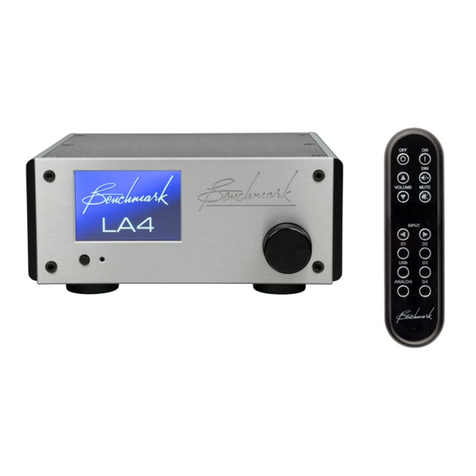
Benchmark
Benchmark LA4 User manual
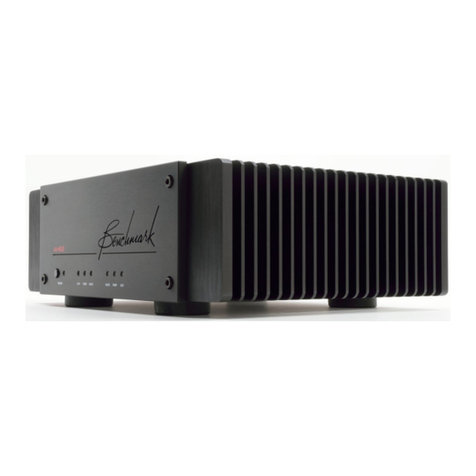
Benchmark
Benchmark AHB2 User manual
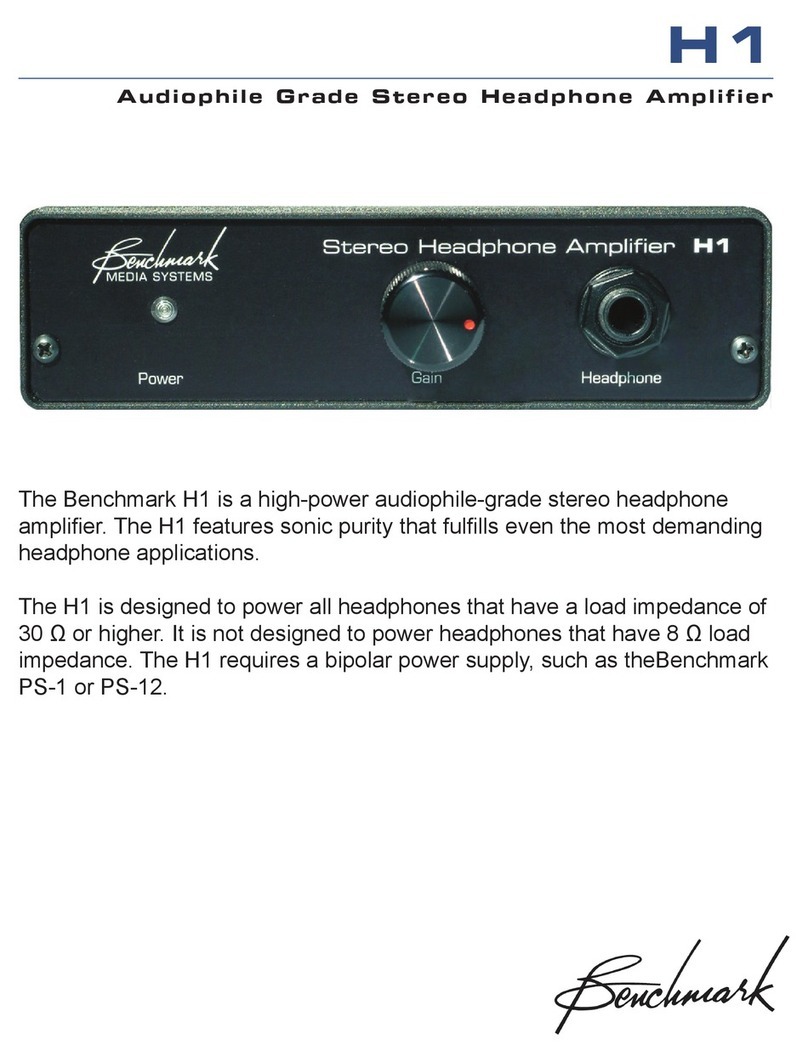
Benchmark
Benchmark h1 User manual
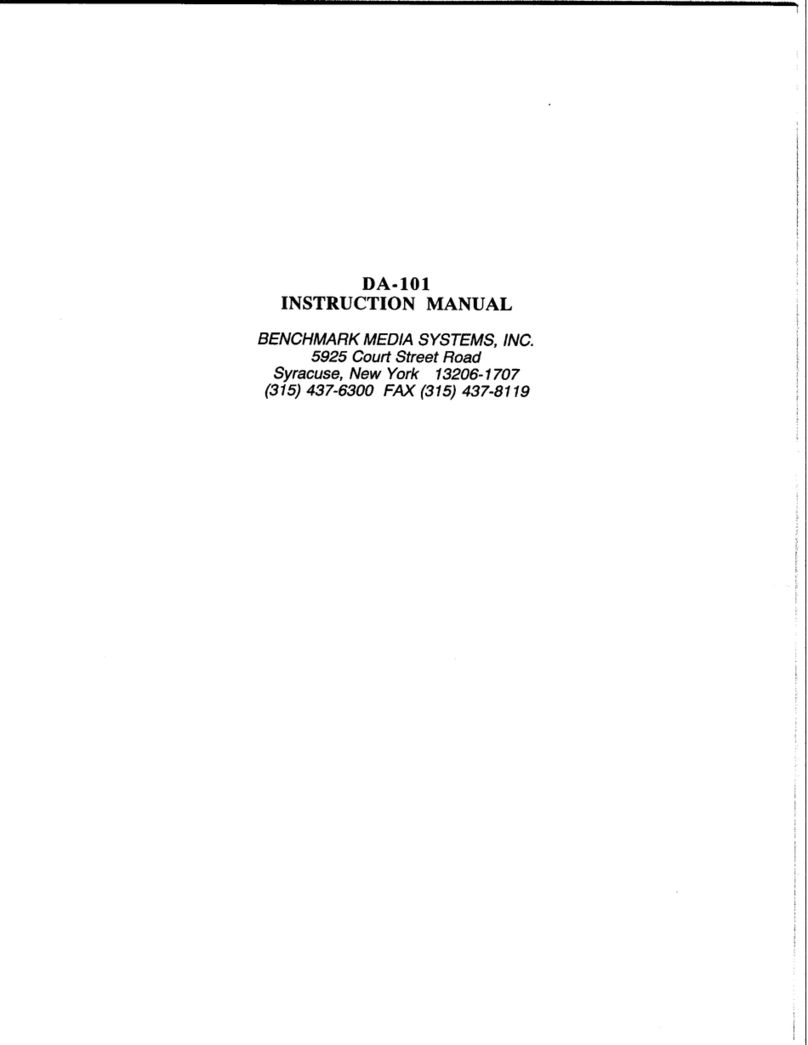
Benchmark
Benchmark DA-101 User manual
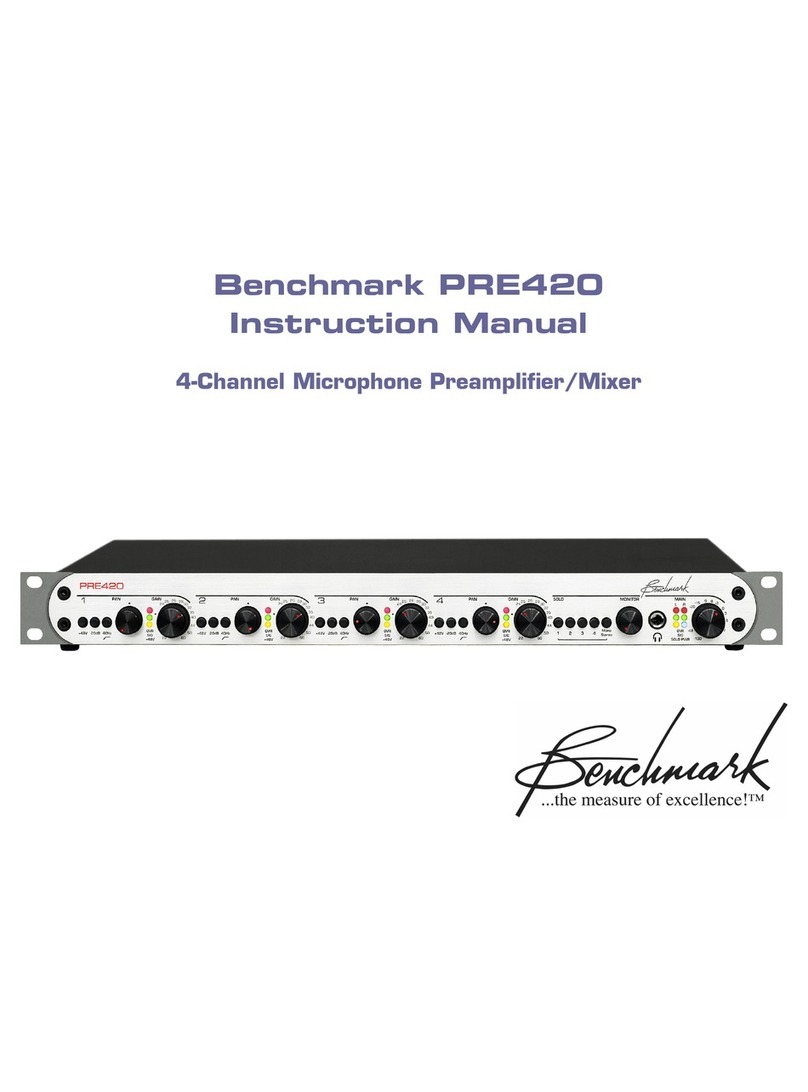
Benchmark
Benchmark PRE420 User manual
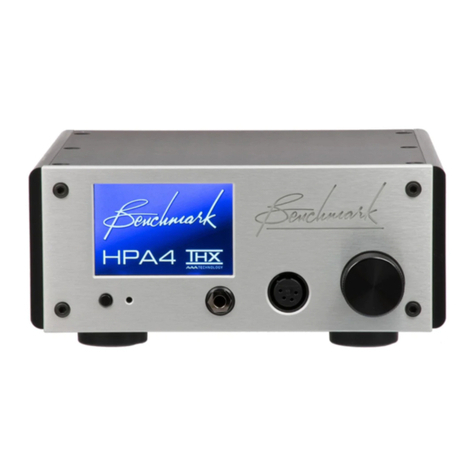
Benchmark
Benchmark HPA4 Quick start guide
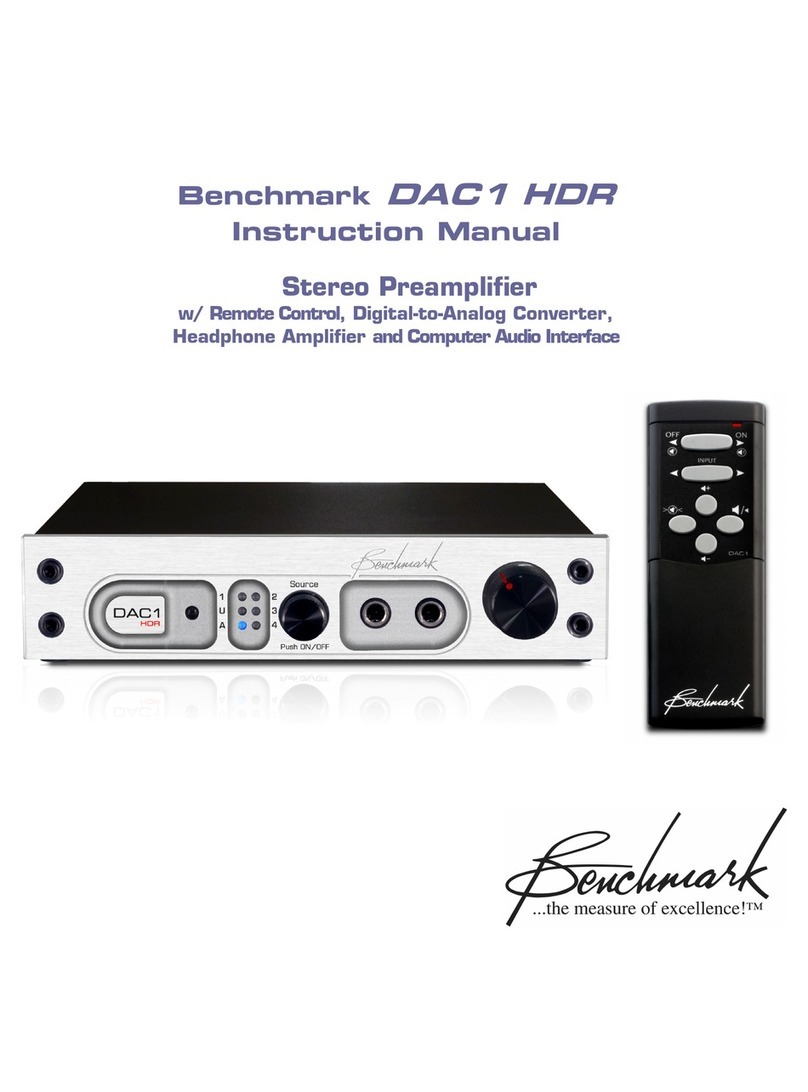
Benchmark
Benchmark DAC1 HDR User manual
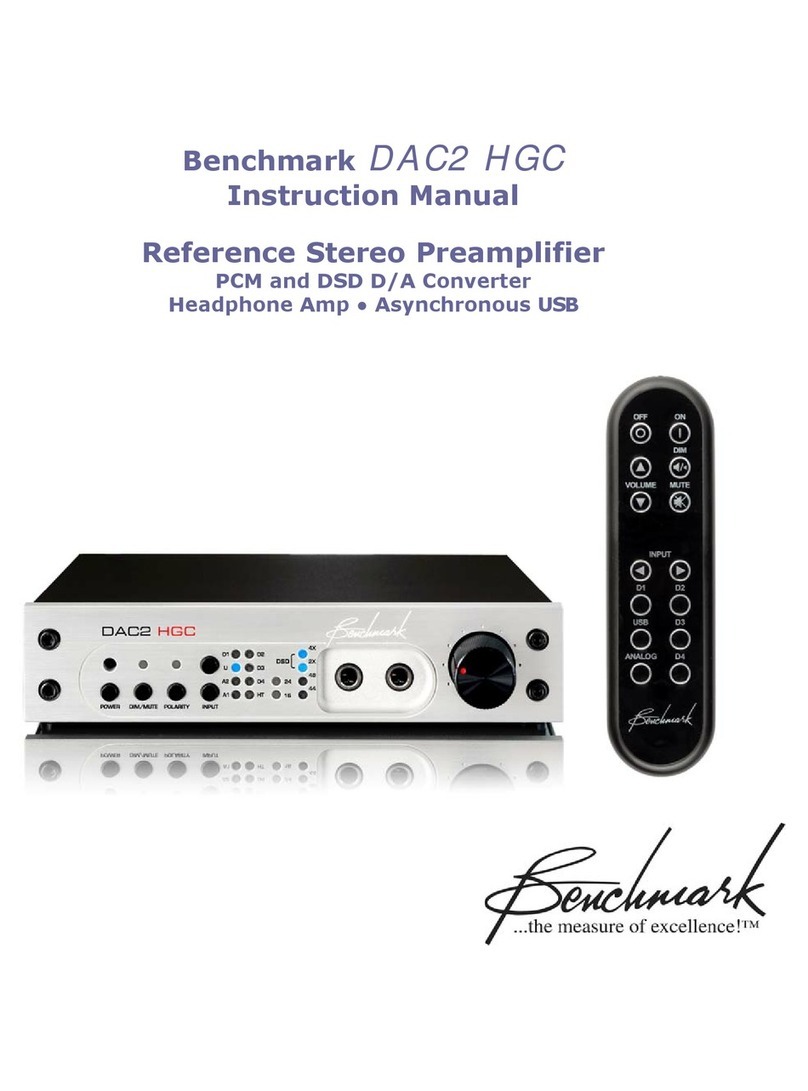
Benchmark
Benchmark DAC2 HGC User manual

Benchmark
Benchmark HPA4 User manual

Benchmark
Benchmark DAC2 HGC User manual
Popular Amplifier manuals by other brands

Behringer
Behringer Powerplay Pro HA4600 Technical specifications

RDL
RDL HD-PA35 HD-Series Installation and operation

U.S. Amps
U.S. Amps Amp Owner's manual and installation guide

Black Lion Audio
Black Lion Audio 500 Series owner's manual
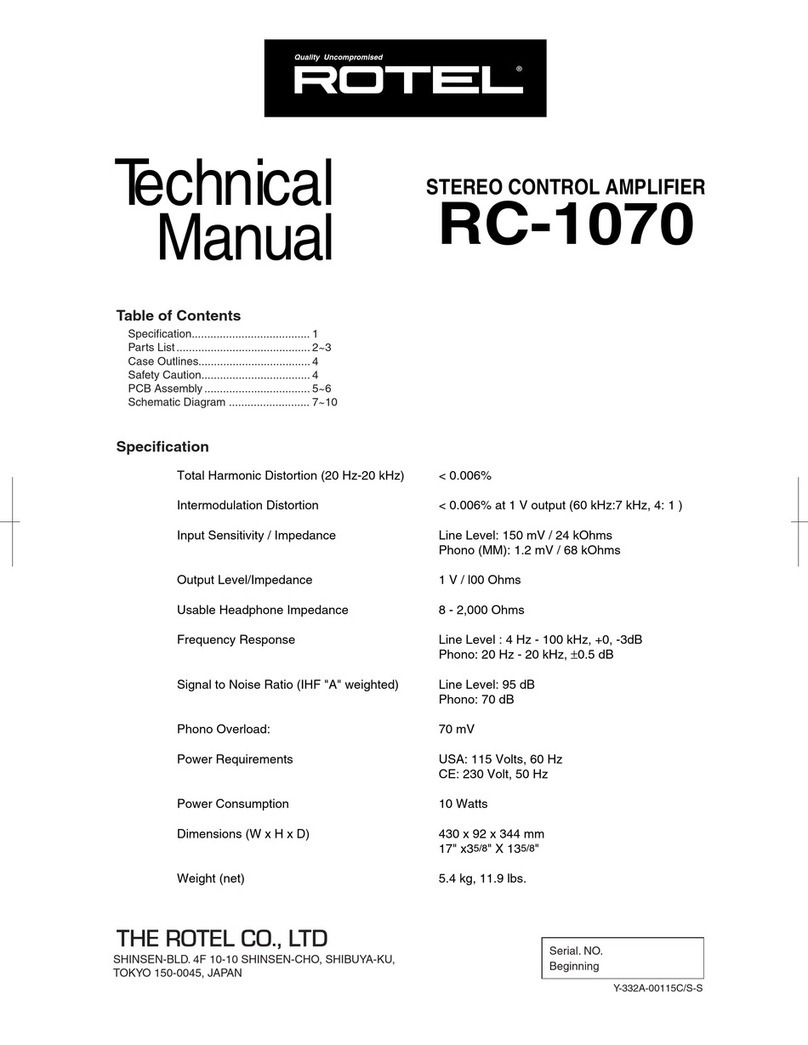
Rotel
Rotel RC-1070 Technical manual

Sony
Sony TA-A790N Service manual

